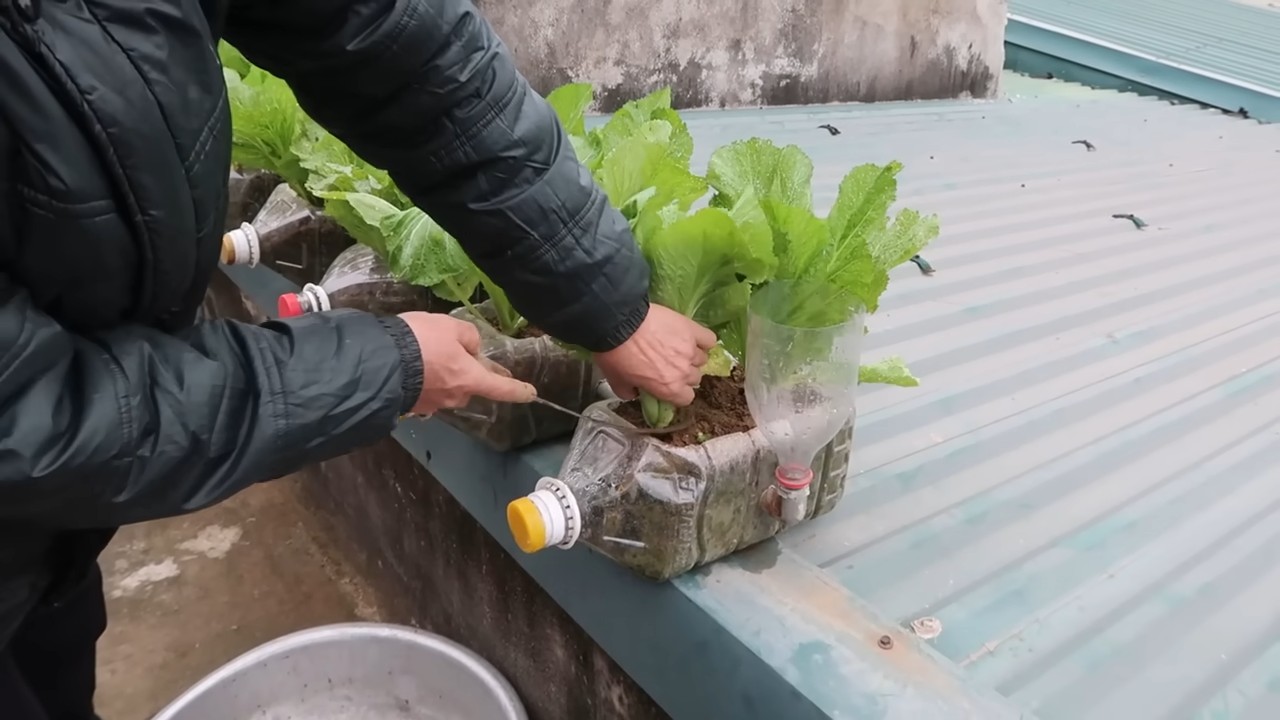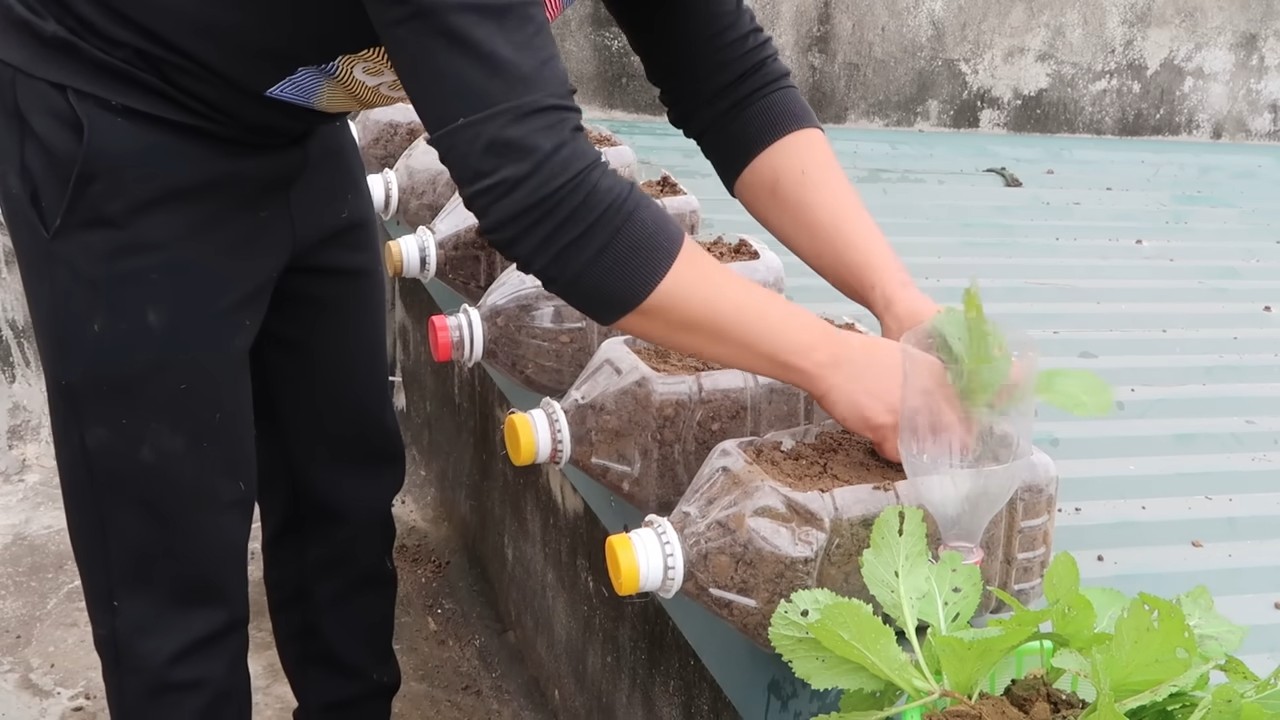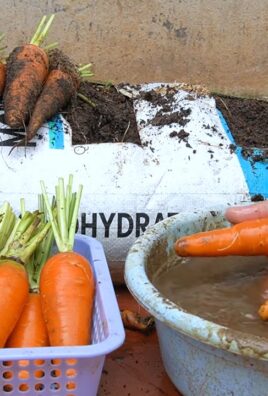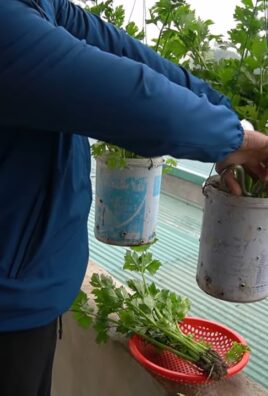Easy vegetable gardening tricks are the secret weapon for anyone dreaming of fresh, homegrown goodness without the back-breaking labor! Have you ever looked longingly at those picture-perfect vegetable gardens, imagining yourself harvesting juicy tomatoes and crisp lettuce, only to be intimidated by the perceived complexity? I know I have! For centuries, cultivating our own food has been a cornerstone of human civilization, from ancient Roman kitchen gardens to the vibrant community plots of today. But let’s face it, modern life is busy, and not everyone has the time or space for a sprawling farm.
That’s where these clever DIY hacks come in. We’re talking about simple, effective techniques that can transform even the smallest balcony or patio into a thriving vegetable patch. Imagine the satisfaction of snipping fresh herbs for dinner, knowing you grew them yourself! These easy vegetable gardening tricks aren’t just about convenience; they’re about connecting with nature, reducing your carbon footprint, and enjoying the unparalleled flavor of homegrown produce. Plus, it’s a fantastic way to de-stress and get your hands dirty (literally!). So, if you’re ready to ditch the grocery store veggies and embrace the joy of homegrown goodness, keep reading! I’m about to share some game-changing DIY secrets that will have you harvesting a bounty in no time, no green thumb required!

Easy Vegetable Gardening Tricks for a Bountiful Harvest
Okay, let’s dive into some super easy vegetable gardening tricks that will have you harvesting like a pro, even if you think you have a black thumb! I’m going to share some of my favorite tips and tricks that have helped me grow tons of delicious veggies with minimal effort. Get ready to get your hands dirty!
Choosing the Right Location
Before we even think about seeds, let’s talk location, location, location! This is crucial for success.
* Sunlight is King (or Queen!): Most vegetables need at least 6-8 hours of direct sunlight per day. Observe your yard throughout the day to see where the sun shines the longest. South-facing areas are usually best.
* Good Drainage is a Must: Soggy soil is a vegetable garden’s worst enemy. Make sure your chosen spot drains well. You can test this by digging a hole and filling it with water. If it takes more than a few hours to drain, you’ll need to amend the soil or choose a different location.
* Proximity to Water: Lugging heavy watering cans across the yard is no fun. Choose a spot that’s close to a water source. A hose or even a rain barrel nearby will make your life so much easier.
* Consider the Soil: Healthy soil is the foundation of a healthy garden. If your soil is poor (sandy, clay-heavy, or lacking nutrients), you’ll need to amend it with compost and other organic matter. We’ll talk more about soil later!
Starting with the Right Soil
Good soil is the secret weapon of any successful gardener. Don’t underestimate its importance!
* Soil Testing: Before you start amending, it’s a good idea to get your soil tested. This will tell you its pH level and nutrient content. You can usually get a soil testing kit from your local garden center or extension office.
* Amending the Soil: Most garden soils benefit from being amended with organic matter. Compost is your best friend here! It improves drainage, adds nutrients, and helps retain moisture. Other good options include aged manure, leaf mold, and peat moss.
* No-Dig Gardening (Lasagna Gardening): This is one of my favorite methods for creating a new garden bed. It involves layering organic materials like cardboard, leaves, grass clippings, and compost on top of the existing soil. Over time, these layers decompose and create a rich, fertile growing medium. It’s a great way to get rid of yard waste and build a garden bed without any digging!
Easy Vegetable Choices for Beginners
Not all vegetables are created equal. Some are much easier to grow than others, especially for beginners. Here are a few of my top picks:
* Lettuce and Salad Greens: These are fast-growing and relatively low-maintenance. You can even grow them in containers.
* Radishes: Radishes are super speedy! You can harvest them in as little as 3-4 weeks.
* Bush Beans: Bush beans are easy to grow from seed and produce a bountiful harvest.
* Zucchini: Zucchini is notoriously prolific. Be prepared to share with your neighbors!
* Tomatoes (Determinate Varieties): Determinate tomato varieties are more compact and don’t require as much pruning as indeterminate varieties.
* Peppers: Peppers are relatively easy to grow, especially if you start with transplants.
* Cucumbers (Bush Varieties): Bush cucumbers are more compact and easier to manage than vining varieties.
* Herbs: Herbs like basil, mint, oregano, and thyme are easy to grow and add flavor to your cooking.
Seed Starting vs. Transplants
You have two options for starting your vegetable garden: starting seeds indoors or buying transplants (seedlings) from a garden center.
* Starting Seeds Indoors: This gives you more control over the growing process and allows you to start plants earlier in the season. However, it requires more time and effort.
* Buying Transplants: This is a quicker and easier option, especially for beginners. You can find a wide variety of vegetable transplants at most garden centers.
Step-by-Step Planting Guide
Okay, let’s get down to the nitty-gritty of planting!
1. Prepare the Soil: Whether you’re planting in the ground or in containers, make sure the soil is loose and well-drained. Amend with compost as needed.
2. Choose Your Seeds or Transplants: Select the vegetables you want to grow and decide whether you’ll start from seed or buy transplants.
3. Follow Planting Instructions: Read the seed packet or plant tag carefully and follow the instructions for planting depth and spacing.
4. Water Thoroughly: After planting, water the soil thoroughly to help the seeds or transplants settle in.
5. Mulch: Apply a layer of mulch around your plants to help retain moisture, suppress weeds, and regulate soil temperature. Straw, wood chips, and shredded leaves are all good options.
Watering Wisely
Watering is essential for a healthy vegetable garden, but it’s important to do it correctly.
* Water Deeply and Less Frequently: Instead of watering lightly every day, water deeply and less frequently. This encourages roots to grow deeper, making plants more drought-tolerant.
* Water at the Base of the Plants: Avoid wetting the foliage, as this can promote fungal diseases.
* Water in the Morning: Watering in the morning allows the foliage to dry out during the day, reducing the risk of disease.
* Use a Soaker Hose or Drip Irrigation: These methods deliver water directly to the roots, minimizing water waste and reducing the risk of disease.
Fertilizing for Growth
Vegetables need nutrients to grow and produce a bountiful harvest.
* Choose a Balanced Fertilizer: Look for a fertilizer that contains nitrogen (N), phosphorus (P), and potassium (K). These are the three main nutrients that plants need.
* Follow Fertilizer Instructions: Read the fertilizer label carefully and follow the instructions for application rates and timing.
* Organic Fertilizers: Organic fertilizers like compost tea, fish emulsion, and seaweed extract are gentle on the environment and provide a slow-release source of nutrients.
Weed Control Strategies
Weeds compete with your vegetables for water, nutrients, and sunlight.
* Mulch: Mulch is your best friend when it comes to weed control. It smothers weeds and prevents them from germinating.
* Hand-Pulling: Regularly hand-pull weeds, especially when they’re small.
* Hoeing: Use a hoe to cultivate the soil and remove weeds.
* Avoid Herbicides: Herbicides can harm your vegetables and the environment.
Pest and Disease Management
Pests and diseases can wreak havoc on your vegetable garden.
* Inspect Plants Regularly: Check your plants regularly for signs of pests or diseases.
* Identify the Problem: Before you take any action, make sure you know what you’re dealing with.
* Use Organic Pest Control Methods: Try organic pest control methods like insecticidal soap, neem oil, and Bacillus thuringiensis (Bt).
* Promote Good Air Circulation: Good air circulation helps prevent fungal diseases.
* Remove Diseased Plants: Remove any diseased plants from your garden to prevent the spread of disease.
Harvesting Your Bounty
Harvesting is the most rewarding part of vegetable gardening!
* Harvest at the Right Time: Harvest vegetables when they’re ripe and at their peak flavor.
* Use the Right Tools: Use sharp scissors or a knife to harvest vegetables.
* Store Vegetables Properly: Store vegetables in a cool, dry place to prolong their shelf life.
Container Gardening for Small Spaces
Don’t have a lot of space? No problem! You can still grow a thriving vegetable garden in containers.
* Choose the Right Containers: Select containers that are large enough for the vegetables you want to grow.
* Use a Good Quality Potting Mix: Don’t use garden soil in containers. Use a good quality potting mix that drains well.
* Water Frequently: Containers dry out more quickly than garden beds, so you’ll need to water them more frequently.
* Fertilize Regularly: Container-grown vegetables need to be fertilized regularly.
Succession Planting for Continuous Harvests
Succession planting is a technique that involves planting crops at intervals to ensure a continuous harvest throughout the growing season.
* Plant Fast-Growing Crops: Plant fast-growing crops like lettuce, radishes, and spinach every few weeks.
* Plant Different Varieties: Plant different varieties of the same vegetable that mature at different times.
* Use Transplants: Use transplants to get a head start on the growing season.
Vertical Gardening for Maximum Space
Vertical gardening is a great way to maximize space in a small garden.

Conclusion
So, there you have it! These easy vegetable gardening tricks are more than just shortcuts; they’re a pathway to a more abundant, sustainable, and enjoyable gardening experience. We’ve covered everything from maximizing your space with vertical gardening to creating nutrient-rich soil with simple composting techniques, and even explored the magic of companion planting to naturally deter pests and boost yields.
Why is this a must-try? Because gardening shouldn’t feel like a chore. It should be a rewarding journey, a connection to nature, and a source of fresh, healthy food for you and your family. These tricks are designed to simplify the process, making it accessible to everyone, regardless of their experience level or the size of their garden. Imagine harvesting your own juicy tomatoes, crisp lettuce, and flavorful herbs, all grown with your own hands using these simple yet effective methods.
But don’t just take our word for it. The beauty of gardening lies in its adaptability and the endless possibilities for experimentation. Feel free to adapt these techniques to suit your specific needs and preferences.
Here are a few variations to consider:
* Vertical Gardening with a Twist: Instead of traditional trellises, try using repurposed pallets or even old ladders to create unique vertical gardens. You can also experiment with different types of containers, such as hanging baskets or stacked planters.
* Composting with a Worm Bin: If you’re looking for a faster and more efficient way to compost, consider using a worm bin. Worms break down organic matter much faster than traditional composting methods, and they also produce nutrient-rich castings that are excellent for your plants.
* Companion Planting for Specific Pests: Research which plants are most effective at deterring specific pests in your area. For example, marigolds are known to repel nematodes, while basil can help keep away aphids and whiteflies.
* Seed Starting Indoors: Extend your growing season by starting seeds indoors a few weeks before the last frost. This will give your plants a head start and allow you to harvest earlier.
* Watering Wisely: Implement a drip irrigation system or use soaker hoses to deliver water directly to the roots of your plants, minimizing water waste and preventing fungal diseases.
We encourage you to embrace these easy vegetable gardening tricks and discover the joy of growing your own food. Start small, experiment with different techniques, and don’t be afraid to make mistakes. Gardening is a learning process, and every season brings new opportunities to improve your skills and knowledge.
Most importantly, we want to hear about your experiences! Share your successes, your challenges, and your own unique gardening tips in the comments below. Let’s create a community of gardeners who are passionate about growing their own food and sharing their knowledge with others. Together, we can make gardening more accessible, sustainable, and enjoyable for everyone. So, get your hands dirty, embrace these easy vegetable gardening tricks, and watch your garden flourish!
Frequently Asked Questions (FAQ)
What if I don’t have a lot of space for a garden?
That’s perfectly fine! Many of these easy vegetable gardening tricks are designed for small spaces. Vertical gardening, for example, allows you to grow a surprising amount of food in a limited area. You can use containers, hanging baskets, or even create a vertical garden on a balcony or patio. Companion planting can also help you maximize your space by growing multiple plants in the same area. Even a small herb garden on a windowsill can make a big difference in your cooking.
How do I know which plants are best suited for my climate?
The best way to determine which plants are best suited for your climate is to consult your local extension office or garden center. They can provide you with information on the growing season, average temperatures, and soil conditions in your area. You can also find a wealth of information online by searching for “vegetable gardening in [your region].” Look for plants that are known to be heat-tolerant, cold-tolerant, or drought-resistant, depending on your climate.
What if I don’t have a green thumb?
Don’t worry! Gardening is a skill that can be learned over time. Start with easy-to-grow vegetables like lettuce, spinach, radishes, and herbs. These plants are relatively low-maintenance and can tolerate a wide range of conditions. As you gain experience, you can gradually expand your garden and try growing more challenging plants. Remember, even experienced gardeners make mistakes, so don’t be discouraged if things don’t always go as planned.
How much time do I need to dedicate to gardening?
The amount of time you need to dedicate to gardening will depend on the size of your garden and the types of plants you’re growing. However, even a small garden can require a few hours of work per week. This includes tasks like watering, weeding, fertilizing, and harvesting. The more time you invest in your garden, the more rewarding it will be. However, you can also use these easy vegetable gardening tricks to minimize the amount of time you spend on maintenance.
How do I deal with pests and diseases in my garden?
Companion planting is a great way to naturally deter pests and diseases. For example, planting marigolds near tomatoes can help repel nematodes, while basil can help keep away aphids and whiteflies. You can also use organic pest control methods, such as insecticidal soap or neem oil. If you’re dealing with a disease, make sure to remove any infected plants immediately to prevent the spread of the disease. Proper watering and ventilation can also help prevent fungal diseases.
What kind of soil is best for vegetable gardening?
The best soil for vegetable gardening is a well-draining, nutrient-rich soil that is slightly acidic (pH 6.0-7.0). You can improve your soil by adding compost, manure, or other organic matter. You can also test your soil to determine its pH level and nutrient content. If your soil is too acidic, you can add lime to raise the pH. If your soil is too alkaline, you can add sulfur to lower the pH.
How often should I water my vegetables?
The frequency of watering will depend on the type of plant, the weather conditions, and the soil type. In general, vegetables need about 1 inch of water per week. However, during hot, dry weather, you may need to water more frequently. The best way to determine if your plants need water is to check the soil moisture. If the top inch of soil is dry, it’s time to water.
Can I grow vegetables in containers?
Yes, you can definitely grow vegetables in containers! In fact, container gardening is a great option for people who have limited space or poor soil. When choosing containers, make sure they are large enough to accommodate the roots of the plants you’re growing. Also, make sure the containers have drainage holes to prevent waterlogging. Use a high-quality potting mix and fertilize your plants regularly.
What are some good resources for learning more about vegetable gardening?
There are many great resources available for learning more about vegetable gardening. Your local extension office is a great place to start. They can provide you with information on local growing conditions, pest control, and other gardening topics. You can also find a wealth of information online, in books, and in magazines. Look for resources that are specific to your region and your gardening goals. Don’t be afraid to experiment and learn from your mistakes. Gardening is a journey, and the more you learn, the more rewarding it will be.




Leave a Comment